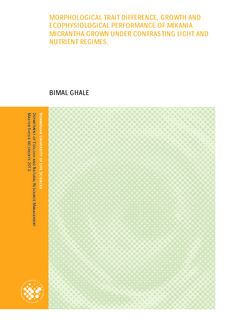Morphological Trait Difference, Growth and Ecophysiological Performance of Mikania micrantha Grown Under Contrasting Light and Nutrient Regimes
Master thesis

View/
Date
2013-08-06Metadata
Show full item recordCollections
- Master's theses (INA) [593]
Abstract
Mikania micrantha , a world’s worse weed, is rapidly expanding throughout the subtropical and tropical parts of Asian countries. Abundant growth and development of
Mikaniavines make them dominant over introduced habitat and causes significant damage to
native floras, faunas and entire ecosystems. To investigate the role of environmental
resources associated with its rapid growth and development, Mikania seedlings were grown
at green house chamber by manipulating two levels of light and nutrient for 110 days. Total
thirteen harvests had performedthroughout the study period on the weekly basis. Specific leaf
area, leaf area ratio, leaf weight ratio, root weight ratio, relative growth rate, net assimilation
rate and total biomass of seedlings grown under light and nutrient treatments were measured
in each harvest. Photosynthetic performance of mature and fully grown Mikania seedlings
was measured at 9th and 11th harvests. Mikania seedlings grown under full sun light and
nutrient rich soil had allocated greater amount of total leaf area and total chlorophyll content
capturedthe higher intensities of solar irradiances to attain maximum photosynthetic rate. Due
to opportunistic capture and utilization of more resources for their physiological process and
morphological allocation patternthe seedlings grown under full sun light with nutrient rich
soil achievedcomparatively higher degree of net assimilation rate (NAR)and relative growth
(RGR) than the seedlings grown at resource limited treatments. The seedlings grown under
full sun light andnutrient rich soil had attained maximum biomass performance indicating the
interaction effect between full light and high soil nutrient resources. Mikaniaseedlings grown
under resource limited treatments had observed poor growth performance however these
seedlings modified their morphological allocations such as
higher specific leaf area and leaf area ratio to assimilatemore resources from the existing
environment. The abilities of Mikania to tolerate adverse environmental conditions and
efficiently utilize higher intensities of sun light and soil nutrient to increase overall
performance and greater proportion of biomass allocation on aboveground parts make them
to grow dominantly over the introduced habitat.